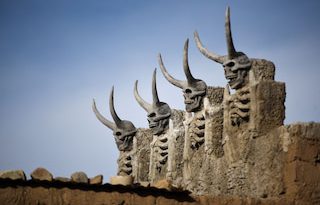Untangling the conflict in Libya
Reuters
Libya’s fault lines surfaced nine years ago as local groups took different positions in the NATO-backed uprising that toppled Muammar Gaddafi.
Rival authorities have backed a ceasefire in Libya, raising the prospect of a de-escalation in the country’s long-running conflict. Achieving a lasting deal will require political and economic agreements that have proved elusive for years, and cooperation from foreign powers.
Who’s been fighting who?
Khalifa Haftar’s Libyan National Army (LNA) has been battling forces aligned with the Tripoli-based Government of National Accord (GNA). Both sides are formed from local armed factions, whose shifting loyalties have helped steer the course of the conflict.
Both have depended heavily on foreign allies pursuing strategic and political goals in Libya. Turkey stepped up its military support for the GNA in January after signing a maritime deal with Tripoli.
Haftar has long enjoyed backing from countries including the United Arab Emirates, Egypt, Russia and Jordan.
How did we get there?
Libya’s fault lines surfaced nine years ago as local groups took different positions in the NATO-backed uprising that toppled Muammar Gaddafi.
An attempted democratic transition slid out of control as armed groups built local power bases and coalesced round rival political factions.
After a battle for Tripoli in 2014, one faction moved east and set up a parallel government and institutions. It recognised Haftar as chief as he began a long campaign against the Islamist groups and other opponents in Benghazi.
The GNA emerged from a December 2015, U.N.-backed agreement struck as Islamic State gained a foothold in Libya and migrant smuggling to Europe surged.
Haftar consolidated control of the east and swept south in early 2019 before launching his offensive on Tripoli.
Who controls what?
Front lines are drawn at LNA-held Sirte, roughly the midpoint of Libya’s Mediterranean coastline and a gateway to major oil ports.
The GNA and affiliated groups seized Libya’s densely populated northwest and the LNA governs the east. Allegiances in the south are more tenuous.
What’s the Damage?
Nearly 400,000 Libyans have been displaced over the past nine years. Thousands more have died.
The conflict has cost tens of billions of dollars in lost oil revenue, damaged infrastructure, and sharply reduced living standards.
Coronavirus infections have started to surge.
The collapse of public services has fueled protests in western Libya against the political elite.
What chance of Peace?
Fighting stopped in June but both sides have continued to mobilise. The ceasefire call by GNA head Fayez al-Sarraj proposed demilitarising Sirte, allowing an oil restart by freezing revenues until a political deal is reached, and elections in March.
But it is unclear how much backing those ideas have in the west, let alone the east.
The LNA dismissed the Sarraj’s announcement as a ploy. A parallel ceasefire call by Aguila Saleh, head of an eastern parliament aligned with Haftar, proposed Sirte as the seat of a new government.
The United Nations is pushing the two sides to resolve issues including oil revenue distribution, the make-up of a unity government and the status of armed groups.
Foreign powers officially back the process, but have also shipped arms to their allies, undercutting diplomatic efforts.
What happened to the Oil?
OPEC member Libya holds Africa’s largest oil reserves, producing 1.6 million barrels per day before 2011. Blockades have caused output to fluctuate sharply since then.
Production climbed to around one million bpd from late 2016, then plunged to less than 100,000 bpd as the LNA’s allies closed ports and pipelines in January.
The National Oil Corporation says it will restart exports only if military forces leave oil facilities.



